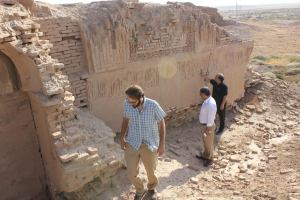: Life with Heritage
What can cultural heritage do for business in Africa?
HERITΛGE celebrated African Heritage Day on May 5th by taking part in an online webinar organized by the Women in Africa Initiative (WIA). WIA is the leading international platform for the economic development and support of African women entrepreneurs and, accordingly, the topic under discussion was whether preserving a country’s heritage assets can serve as the basis for building a successful business.
Dr. Evangelos Kyriakidis, HERITΛGE Director, and the organization’s Head of Africa Programmes, Mina Morou, both contributed to the webinar which was moderated by Oluwatoyin Adegbite-Moore, Founder & CEO of Nigeria’s SHEAFAM & TAM, a consulting business, and Executive Vice-President for Africa & Europe, for financial services company REACH HQ.
They were joined on the panel by Harriet Ng’Ok, Founder of Harriet’s Botanicals and HERITΛGE alumna, and Zaahirah Muthy, Founder OF ZeeArts Gallery, philanthropist, artist activist, and WIA Ambassador.
Adegbite-Moore kicked off the discussion by asking whether heritage can help business and how can business help heritage.
“In many ways, heritage consists of unique content, of privileged knowledge for local communities anywhere. And this privileged knowledge can become a unique selling point for business and can help business branding, business quality, etc. while at the same time, business with its products and services can actually really strengthen these heritage values and empower them,” said Dr. Kyriakidis.
Ng’Ok founded Harriet’s Botanicals, an African-sourced wellness products company, after being helped herself by her community’s traditional medicine that uses locally-found plants. She joined the discussion from Kenya.
“My idea was to bring cultural practitioners together and formalize their trade… we have grown in leaps and bounds. We now have a factory and manufacture up to 500 bottles on any given day … We are the beginning of African medicine featuring on a global platform just like other cultures, like the Chinese and the Ayurvedic are,” Ng’Ok said.
“The reason I named our first product Arorwet and maintained the name of this tree is that people in the village would begin to understand the value of the traditional indigenous trees and not cut them for firewood or for sale and would start instead to regrow them on their farms,” she added.
Below you can find out more and watch the webinar which was on the day attended by around 1000 people on the day.
ABOUT AFRICAN WORLD HERITAGE DAY: Proclaimed by UNESCO in 2015, African World Heritage Day (5 May) is an opportunity for people around the world, particularly Africans, to celebrate the Continent’s unique cultural and natural heritage. While Africa is underrepresented on the World Heritage List (African properties account for some 12% of all inscribed sites worldwide), a disproportionally high percentage (39%) of these properties are on the World Heritage List in Danger. It is therefore more urgent than ever that this irreplaceable heritage be protected and preserved for the enjoyment of future generations.
HERITΛGE is currently working to untap the potential of heritage in Africa through its Heritage Management Project – Africa (HerMaP-Africa) program which is funded by the Mellon Foundation’s Humanities in Place program and through its HerMaP Gambia program which is co-funded by the European Union.
If You’ve Got It, Flaunt It: Using Heritage In Brand Marketing
Weaving in and out of the crowds during the Christmas sales at one of Britain’s larger shopping centres, a digital window display suddenly caught my eye. An enormous Dominic West loomed above the heads of busy shoppers, although for some reason the Hollywood actor had swapped his Jimmy McNulty uniform for a roll-neck jumper and fisherman’s hat. He also sported a frosty beard. Moments later the screen flickered, and text rolled across the image: ‘Dominic West is Ernest Shackleton’.

Actor Dominic West as polar explorer Ernest Shakleton in Burberry’s 2016 campaign (http://www.thefashionisto.com/tale-thomas-burberry-2016-campaign/)
Unfortunately this was not a well-timed seasonal advertisement for half-price ice picks and crampons. The truth was less exciting. The glossy image was simply British fashion house Burberry’s latest ad-campaign: a glamorous cinematic take on the life of its founder, Thomas Burberry. The advert shows key moments from Burberry’s history, in particular those which purport to have shaped the company’s values and image. Polar explorer Shackleton wore Burberry gabardine (the weatherproof fabric used for its iconic raincoats) in the Antarctic so, presumably, if you’re looking for a coat that can withstand temperatures up to -40 degrees celsius, Burberry is the place to go.
A visit to any UK shopping centre or up-market high street will involve a number of brands for whom “heritage” is a key aspect of their marketing strategy. Burberry, Mulberry, Barbour, Hunter, Harrods and Asprey are just a few of the companies who trade on their British heritage to reassure customers that they are buying into quality and craftsmanship. Perhaps unsurprisingly, these types of heritage brands are usually synonymous with luxury brands, as the time that goes into creating quality clothing and accessories results in higher prices.
So why is this idea of “heritage” so important for certain brands? Celebrity endorsements come and go, new ideas can be copied, innovations can be outdone – but a brand’s history is unique. By centering their marketing around their brands heritage, companies like Burberry are able to leverage strong feelings of nostalgia and pride, as well as inspiration, envy and desire. By flaunting their heritage these brands reassure potential new buyers that they will be joining a long line of satisfied customers. Why risk your money on the modern and untested, when you can be safe in the knowledge that your £1400 trench-coat even withstood arctic conditions one hundred years ago.
However, heritage-based marketing is not only for the top end of the market. Everyday brands have also found they can use a loose definition of “heritage” to their advantage. In 2008, British bread manufacturer Hovis produced a television advert that followed the journey of a young boy through 122 years of bread-based history. Firmly targeted at a lower income audience, Hovis convinces its customers that even through the terror of two world wars its bread remained reassuringly familiar – a constant presence in a turbulent century. Combined with the tagline “as good today as it’s always been”, the marketing campaign increased Hovis’ share of the UK bread market and even had a halo effect on the profit margin of it’s parent company, Premier Foods.

The “lad” passes WW1 soldiers as he brings home his Hovis bread from the 2008 Hovis campaign “Go On Lad”. (Screenshot from https://www.youtube.com/watch?v=s_suyZb5mDk)
Even Stella Artois, the Belgian beer that only a few years ago was referred to in the UK as ‘wife beater’ due to its high alcohol content (and resulting connotations with binge drinking and violence) has recently presented a new marketing campaign focused around its heritage. Similar to the Burberry campaign, Stella Artois’ grammatically troubling ‘Be Legacy’ showcases important moments from the brand’s six-hundred year history with the aim to inspire confidence in and respect for the product. However, not content with simply referencing the past, Stella Artois also invests in the heritage of the future: copy at the end of each television advert reads ‘what do you want to be remembered for?’.

Stella Artois’ Be Legacy campaign, featuring founders Sebastian and Isabella Artois. (http://www.stellaartois.com/en_gb/home.html)
Even when a brand does not explicitly use heritage as part of its marketing strategy, many have ‘heritage collections’ within their product lines. From Faberge to Banana Republic, brands have worked out that heritage sells.
So, if heritage can be used to sell everything from trench-coats to pilsner, decorative ceramic eggs to wholemeal bread, why are museums, archaeological sites and other historic properties – all of which contain a wealth of heritage material – constantly fighting for funds and visitors? Perhaps a combined approach to marketing needs to be taken. In June 2016 Gucci collaborated with Westminster Abbey (a UNESCO World Heritage site) to showcase its S/S 2017 collection. As models walked, cameras flashed and fashionistas instagrammed, Gucci designer Alessandro Michele reminded us all that ‘Westminster is a piece of [London’s] energy, something the contemporary world has forgotten…history is what is really cool’.

Gucci models on the catwalk in Westminster Cathedral, June 2016 (screenshot from https://www.youtube.com/watch?v=CZUJD5UdVzU )
Elle Arscott is a candidate for the MA Heritage Management 2016-17, and has an undergraduate degree in History of Art & Music from the University of Edinburgh. She is interested in international arts and antiquities law, as well as heritage marketing and alternative approaches to heritage site management.

Dealing with Issues of Authenticity and Integrity in World Heritage – Along the Silk Route in Iran
Recently I had the opportunity to travel to the Iran, and work with the Iranian Cultural Heritage, Handicrafts, and Tourism Organization (or ICHHTO for short) and as a student of Heritage Management I have to say that as far as life-experiences go, every aspect of the trip was unique, providing with some valuable experience in the issues that arise when dealing with the conservation, protection, and management of world heritage.
The idea behind the trip was that we, my classmate and colleague Hadi Ahmadi of ICHHTO and I, would visit various sites along the Silk Road, travelling westwards from Sarakhs on the eastern border with Turkmenistan, to Qasr-e Shirin on the western border with Iraq, and evaluate their condition, in order to determine whether they would be included in the World Heritage Nomination dossier for the Silk Road Heritage Corridor of Iran. This is an ongoing project by UNESCO with the goal of promoting an international academic dialogue and cultural exchange between the east and the west, by protecting and promoting a very important part of history that is shared by Europe and Asia.

For the first part of this massive project ICHHTO decided that the Caravanserais that are located all over the Silk Road, would best represent Iran’s cultural and economic contribution into the history of this complex road network that spanned 2 continents and 14,000 kilometres. Caravanserais are the “hotels” that were built every 30 or so kilometres to accommodate the traders and travellers that crossed the Silk Road.
Even though the task may seem fairly straight-forward and simple, due to the complex nature of the ownership and history of these sites, it proved to be much harder than we had originally thought. These sites had been continuously used for over 600 years until the invention of the automobile completely changed the nature of the Silk Road, while some of them continued being in use even afterwards for various purposes such as prisons (Caravanserai Robat Sang Bast) or military bases, (Caravanserai Yenge Emam) due to their fortified nature. This meant that very often the authenticity and integrity of the sites would be compromised by architectural interventions from later occupants, or even by irreparable damage caused by natural sources over time. Because of this, we were faced with a dilemma, if we were to assess the historical importance of the sites, with their current condition, we would need to decide at what point the compromised authenticity and integrity of these structures becomes too great for them to accurately represent the cultural, historical, and socio-economic values that they were chosen for.

In reality, this is a very controversial issue, and one that comes down to individual judgement in most cases. Due to each site having a completely different history, different architectural attributes, and representing different cultural and heritage values, there is no singular rule that applies to all of them, and each case needs to be assessed on its own individual merit.

Furthermore, the issue of loss of authenticity and integrity brings up another problem that goes hand-in-hand when trying to define what is considered to be worthy of World Heritage status, at what point in the history of each item of tangible or intangible heritage do we stop considering it to be relevant? This is an issue because a common practice of ICHHTO is to “undo” any changes that were done to a site, in order to restore it to its previous condition. As I previously mentioned, one of the sites we visited was that of the Caravanserai Robat Sang Bast, which after more than 16 years of disuse, was used as a prison for enemy combatants during the war between Iran and Iraq between 1980-1988, and as a prison for the criminally insane up until as recently as 10 years ago. This has completely altered the nature of the site from what its original purpose was as a caravanserai during the years of the Silk Road because of the addition of prison walls and guard towers, turning the guest rooms into cells by adding concrete on the floor and barred doors to prevent escape attempts, as well as barbed wire in many areas to restrict movement of the prisoners. So the issue that we face here is how do we conserve and protect the values this site represents in terms of the Silk Road related heritage, without compromising a different part of its history.
Once again I believe that there really isn’t a “right” answer to this question, and we simply have to approach each case individually and with these issues in mind.
Stefano Vito Mongelli is a post-graduate student of Heritage Management with a background in History and Archaeology.
Hadi Ahmadi currently works for the Iranian Cultural Heritage, Handicrafts, and Tourism Organization, with a BA and MA in Conservation of Architectural Heritage.
Philosophy, Intangibility, and Preparing for Exams
How do I find value or significance in something that has no dimension? As a heritage manager, where do I find the tangible evidence of intangible material? As I walk back towards Kerameikos from the Academy on a beautiful sunlit afternoon, this thought kept running through my brain.
I spent the day sitting on one of the many benches at this former gymnasium basking in the sunshine while studying management strategy. I wandered along the trails in the park and walked among the ruins of the first major institution of learning. I was looking for something that would connect me to this famous place in antiquity. (more…)


